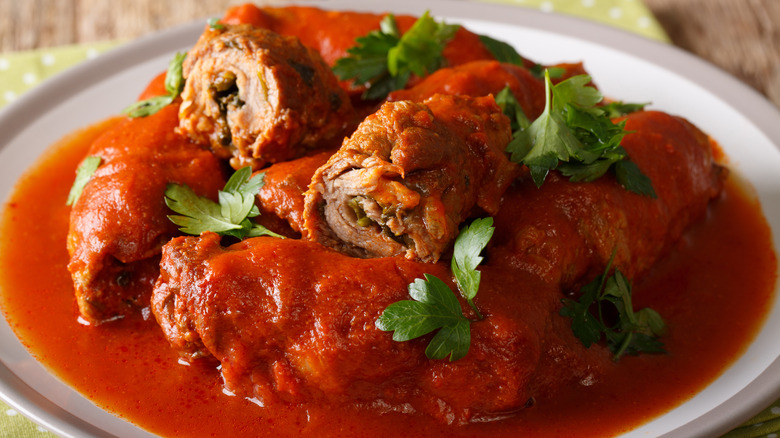Why There Is No 'Authentic' Cut Of Meat For Braciole, According To Chef Anthony Scotto
Authenticity in food is overrated, especially when it comes to homemade comfort food like spicy beef braciole. The hunt for "authentic" recipes is a generally well-meaning backlash to an American food culture that often absorbs and changes dishes from other cultures, with the implicit promise that the original versions are both more "real" and better tasting. This can absolutely be true sometimes, but it also overlooks the regional and family variations on classic recipes and how food naturally evolves as people carry it around the world and adapt to new surroundings.
Few cuisines have fallen victim to that debate like Italian food in America. Beloved Italian-American dishes like chicken parmesan were first popular, then dismissed as fake, then re-embraced as people realized that authenticity is in the eye of the beholder and immigrant cooking is just as real as the traditions of the countries they came from. When it comes to braciole, a dish that has now crossed cultures, an expert like Anthony Scotto knows there is no right answer.
Tasting Table asked Scotto, the chef and owner of Nashville restaurants Pelato and Luogo, about how he makes braciole, and his response was simple: "There are countless ways to make a braciole, with no one way being the end all." The only real guideposts for braciole are that "this was considered a special meal, a splurge for most people and with that said people used whatever they were able to afford," Scotto explained.
Braciole is all about treating yourself to a special meal
Braciole is certainly an old-school meal — rolled meat stuffed and simmered in a pot of hearty tomato sauce — but even back in Italy, there was never one way to make it. While it's heavily associated with beef, pork variations of braciole are also made, and the only real unifying factor is the rolling of meat with fillings. Scotto himself has embraced a style different from most Italian-American versions, telling us, "We find that pork shoulder and other cuts of meat work great as long as the preparation is right."
Even among people who use beef, there isn't really a point of agreement. Flank steak is used when braciole is cooked as one big log and sliced after cooking, while cooks who favor smaller, individual preparations often go with top round. But, even those two are just suggestions at this point.
If you can slice your meat thin and pound it flat, you can make braciole out of it. Top round and flank steak are both more affordable cuts of steak, but there is nothing stopping you from using brisket or sirloin instead. Don't want to work with fatty pork shoulder? Pork tenderloin can easily take its place. As long as your cut will hold up to slow cooking and braising, the only thing that should be holding you back with braciole is how much you can think outside the box.

